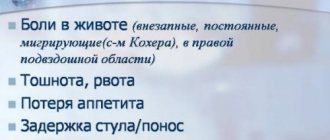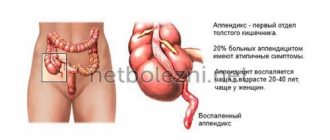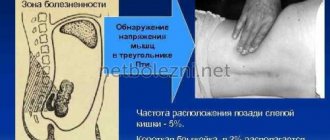Where is the appendix located?
The appendix is an extension of the cecum
Its lower part descends to the pelvis. It can also be located behind the cecum. The organ is small in size: on average, 7-9 cm, its diameter is 0.5-1 cm. A small flap fold separates it from the cecum, preventing intestinal contents from entering the appendix.
Thanks to this, the appendix cavity remains clean. This organ also plays a role in digestion, being a kind of incubator for beneficial bacteria. Not all mammals have this organ.
For example, the cat family does not have this appendage. But rodents have it, for example, rabbits and guinea pigs. Human relatives according to the biological classification - monkeys - also have an appendix. Herbivores have a developed appendix.
What to do to prevent appendicitis, and can it be cured without surgery?
Currently, the only method of treating appendicitis - from the point of view of evidence-based medicine - is surgical treatment, but research is also being conducted on conservative therapy (“Is conservative therapy for acute appendicitis possible?” Prof. S.A. Sovtsov, Prof. A.G. Krieger, Candidate of Medical Sciences O.V. Pribytkova, A.V. Smirnov, Federal State Budgetary Educational Institution of Higher Education "South Ural State Medical University" of the Ministry of Health of Russia, Federal State Budgetary Institution "Institute of Surgery named after A.V. Vishnevsky" of the Ministry of Health of Russia, 2022 .; Early appendectomy vs. conservative management in complicated acute appendicitis in children: A meta-analysis. Fugazzola P, Coccolini F, Tomasoni M, Stella M, Ansaloni L., General and Emergency Surgery dept, Bufalini Hospital, Cesena, Italy. Pediatrics dept. and Neonatal and Pediatric Intensive Care Unit, Bufalini Hospital, Cesena, Italy. 2019, etc.). Yes, of course, people who lead a healthy lifestyle and adhere to a rational, age-appropriate diet have a lower chance of encountering appendicitis. But there is no absolutely effective prevention. Let's proceed from the fact that we all benefit from preventing constipation and regular physical activity - all this allows us to stimulate intestinal function and avoid the formation of fecal stones and spontaneous spasms in the gastrointestinal tract.
The appendix is a branch of the cecum ranging from 4 to 20 centimeters in length and only 1 centimeter in diameter. This worm-like appendage is located where the small intestine meets the large intestine. Bacteria easily colonize in this place and fecal stones can get stuck, so the appendix, consisting of lymphoid tissue, performs immune and protective functions in relation to the intestines. (The tonsils and adenoids protect the respiratory organs in the same way.) Inflammation of the appendix often occurs when its mouth is blocked, usually due to the accumulation of fecal stones. The appendix can also become inflamed after a spasm of the intestines due to the consumption of large amounts of protein foods, fast carbohydrates and foods rich in fats, against the background of an intestinal infection that provokes excessive growth of bacteria in the intestine. In all cases, vasospasm, blood stagnation and swelling of the smooth muscles of the intestines occur. Because of this, the nutrition of the appendix is disrupted, bacteria from the intestinal lumen penetrate the walls of the appendix, and an active inflammatory process begins, which is almost always accompanied by pain.
About Lisa, Yasha and Dima - real stories from mothers
Lisa (8 months old) had a sharp rise in temperature, she cried without interruption for more than an hour, her tummy seemed larger than usual, she had loose stools, and a few hours after the temperature spike, she began to lie down, pulling her legs towards her stomach. I gave her Nurofen, but there was no change in Lisa’s condition, and we went to the hospital. (Later we realized that it was not worth giving Nurofen and wasting time). At the hospital, doctors first suggested an intestinal infection or disease of the abdominal cavity, and also said that this could be a change in the anatomy of the intestine. They did a blood test and found high white blood cells, a high ESR (about 90 units), and a urine test showed no signs of inflammation. Lisa then had an ultrasound, which at first showed nothing but severe flatulence, which made it difficult to see anything else. Then the ultrasound diagnostician began to scrutinize the area of the intestine where the appendix was, and finally saw that it was very inflamed. Diagnosis: acute phlegmonous appendicitis with local peritonitis. A few minutes after the ultrasound, Lisa was already on the surgical table. The laparoscopic surgery went well, Lisa recovered quickly. The doctors told us that we did absolutely the right thing by arriving at the hospital almost immediately, and we, in turn, are very grateful to the doctors for the high-quality diagnosis and successful operation. (Lena, Lisa's mother).
Yasha (6 years old) fell ill with the coxsackie virus at sea, in Turkey. He developed a high temperature, characteristic spots appeared on his legs and arms, and his appetite decreased - everything is as usual with a viral infection. After a couple of days, the temperature dropped, but he did not eat better, even refused ice cream, and drank only water. He was lethargic and thoughtful, but never complained of abdominal pain. We called a doctor, the doctor examined Yasha, and then for the first time, while palpating his abdomen, Yasha screamed that he was in pain. The doctor said that this is most likely a consequence of inflammation caused by the coxsackie virus, it’s okay, continue therapy, and if the temperature persists, come and take a blood test. We asked the question: is this appendicitis? - and received the answer that no, this is pain caused by a virus, due to which, apparently, the liver or intestines were slightly inflamed. It was on Friday, and on Saturday morning Yasha was already holding his stomach, pressing his leg to his stomach and could not get to the toilet on his own. We took him to the hospital in our arms, where he was immediately given a blood test, which showed very high leukocytes and ESR, and an ultrasound revealed that the appendix (yes, it was appendicitis) had already burst. After 20 minutes, Yasha was already on the operating table; the abdominal surgery lasted an hour and a half. Unfortunately, we were unlucky with a general practitioner, and we ourselves did not have sufficient information about how to recognize appendicitis. Please don't repeat our mistakes. (Zhenya, Yasha’s mother).
Dima (10 years old) began to complain of headache and nausea, he vomited several times and was put to bed. I decided that it was a rotavirus, because such cases had happened before. By evening, the temperature rose to 37.8, Dima did not want to eat anything, he drank water and lay down. In the morning the temperature was 37.2, there was no appetite, I insisted that I at least eat oatmeal with water. During the day, Dima complained for the first time of abdominal pain, not severe, according to him. I was at work all day, we called each other, his condition did not change, his stomach did not hurt more. In the morning everything was the same, the temperature remained at 37.2-37.5 and I called a pediatrician from the Central Clinical Hospital and went to work (there was a nanny at home). About two hours later the doctor called me and said that she was calling an ambulance to Dima because there was a serious suspicion of appendicitis. The ambulance arrived with me, Dima was taken to the clinic in Polyanka, they did a blood test, an ultrasound, and immediately took him to surgery. The surgeon said that in just a couple of hours the appendix would have burst, and then laparoscopic surgery would not have been possible. I concluded that when complaining of abdominal pain, even minor ones, the first step is to rule out appendicitis and not trust any of your previous experiences. And, of course, it’s good when there are wonderful, attentive doctors nearby!..)) (Irina, Dima’s mother)
How does appendicitis hurt?
Maximum pain during inflammation of the appendix occurs in the area where it is located, that is, slightly to the right of the umbilical cord. The pain of the appendix, raised closer to the liver, is not difficult to confuse with the pain of the liver itself. If the appendix is lowered to the pelvis, then its pain is masked as an ovarian pathology; in men, as an inflammation of the bladder. When the appendix is located posteriorly, the pain is localized in the lower back and felt in the groin.
Pain appears unexpectedly, without any particular reason. The inflammatory process can begin with mild or tolerable pain, followed by an increase, or it can immediately manifest itself with acute stabbing pain, which will be acute and unbearable as long as living nerve endings are sensitive. Therefore, when the appendix is inflamed, you cannot calm down if the pain subsides. On the contrary, the patient must be urgently hospitalized.
Appendicitis is also characterized by other symptoms: general malaise, nausea, and even single vomiting appear. Lost appetite. The temperature rises to 37.2-37.7o C and may be accompanied by chills. A light coating appears on the tongue. The heart rate increases to 90-100 beats per minute.
The initial period of appendicitis
Children are more susceptible to changes in blood composition. This makes it difficult to diagnose appendicitis in a timely manner. A child's blood contains a much larger number of leukocytes. Because of this, in children the disease at an early stage is easy to miss. It is accompanied by a relatively unnoticeable change in laboratory test results or is not diagnosed at all.
Pain syndrome is attributed to physical activity, general malaise to a cold, digestive problems to stress, and so on. If these signs are present, it is necessary to submit samples of discharge for testing for general composition. Sampling should only be done in the absence of stimuli. A comprehensive blood and urine test is designed to help identify the disease at this stage.
Signs of peritonitis
Since, in case of untimely provision of medical care to the patient, perforation of the appendix and penetration of its contents into the peritoneum, leading to peritonitis, may occur, you should be aware that with peritonitis, the general condition of the patient sharply worsens. The eyes become sunken, the facial features become sharp. The patient begins to show anxiety, the heart rate increases sharply to 120 beats per minute. The pain spreads throughout the abdomen.
Pathological stage
The transition to this stage will show that the permissible level of leukocytes is many times exceeded (2 times or more). The beginning of tissue breakdown threatens general blood poisoning. The accumulating liquid containing the remains of dead leukocytes in the form of suppuration becomes a source of intoxication. It can cause severe anaphylactic shock and coma. The proximity of the appendix to the lymph nodes is particularly dangerous. Only urgent surgery will save a patient with this form of the disease. Drug treatment cannot help in this case. People often die from medical errors when treating peritonitis.
Signs of appendicitis in children
Symptoms of appendicitis are quite characteristic
If an adult can explain where, what and how it hurts, then with a child everything is much more complicated. And the younger the child, the more difficult it is to conduct an anamnesis. He cannot explain either the nature of the pain or its location. The child just hurts everything.
But, having heard that they are leaving him in the hospital and that something will be cut out, the baby may unexpectedly “get well.” Don't flatter yourself. The child does not understand that his deception may cost him his life. He wants to return to his usual life, and be closer to his mother, to his family, to everything that promises him warmth and security.
He may begin to be capricious and throw a tantrum demanding to be taken home. Explain to him that the subsided pain is the death of the nerve endings that should feel pain, and that if he does not listen to the doctor, he may die. Try to be with your child at these moments.
What do the tests say?
If appendicitis is suspected, a complete clinical blood test (CBC) and a general clinical urinalysis (UCA) are taken; it is advisable to do this within the first hours after the onset of the disease. In a general blood test for appendicitis, there should be high leukocytes and a large number of band neutrophils, and the ESR may also increase. But if a child has appendicitis, a urine test is usually normal. And if the urine is not sterile, with bacteria, white blood cells and red blood cells - together, both of these tests indicate a urinary tract infection or renal colic, and you will certainly be referred for an ultrasound and to a pediatrician for antibacterial therapy.
If you have taken tests in the laboratory without calling a doctor, and you see that all urine indicators are normal, and leukocytes, neutrophils and ESR are above normal, do not offer the child any more water or drink, pack a bag with things (passport , policy, birth certificate, SNILS, slippers, pajamas, hygiene products), call an ambulance or go to the hospital yourself.
Attention! Do not give your child any painkillers until examined by a doctor; do not place a heating pad or ice on his stomach so that the picture of appendicitis is not blurred. Your actions can complicate the diagnosis and waste time.
Norm
A person’s need for leukocytes is almost a thousand times less than the need for erythrocytes and, for a mature person, is from 4.0 to 9.0 * 109 cells per liter of blood.
The norm of leukocytes in the blood changes with age. Indicators of leukocyte norms by age are presented in the table.
Table of the norm of leukocytes in human blood depending on age:
| Age, years | Cell count, 107/l |
| <1 | 600-1750 |
| >1<2 | 600-1700 |
| >2<4 | 550-1550 |
| >4<6 | 500-1450 |
| >6<10 | 450-1350 |
| >10<16 | 450-1300 |
| >16 | 400-900 |
A growing organism, with a developing cellular defense system, needs more white blood cells than a mature one.
It is necessary to distinguish between a pathological increase in leukocytes in the blood and a physiological one. So, after breakfast or lunch, after physical overload, in the last months of pregnancy, during women's critical days and after vaccinations, physiological leukocytosis is observed. And, in the case of inflammation, including appendicitis, the appearance of pathological leukocytosis is noticed.
Danger
Appendicitis is classified as a serious disease that requires surgical intervention. Suppuration of the appendix can occur at any age and regardless of gender. Delay in solving the problem of appendicitis is fraught with the occurrence of peritonitis, which often ends in death.
The appendix becomes inflamed due to blockage by feces or foreign objects. The lumen of the intestinal process is blocked by various neoplasms that arise as a result of diseases of infectious and non-infectious etiology.
Inflamed appendicitis









